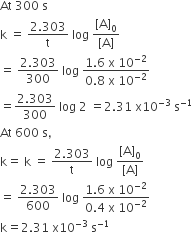 Short Answer Type
Short Answer TypeFollowing data are obtained for the reaction :
N2O5 → 2NO2 + ½O2
| t/s | 0 | 300 | 600 |
| [N2O5]/mol L–1 | 1.6 × 10–2 | 0.8 × 10–2 | 0.4 × 10–2 |
(a) Show that it follows first order reaction.
(b) Calculate the half-life.
(Given log 2 = 0.3010 log 4 = 0.6021)


For the reaction, the rate of formation of NO2 (g) is 2.8 x 10-3 Ms-1. Calculate the rate of disappearance of N2O5 (g).
A first-order reaction is 50% completed in 40 minutes at 300 K and in 20 minutes at 320 K. Calculate the activation energy of the reaction.
(Given: log 2 = 0.3010, log 4 = 0.6021, R = 8.314 JK–1 mol–1)
 Multiple Choice Questions
Multiple Choice QuestionsRate law for the reaction, A+ B → product is rate = k[A]2[B] What is the rate constant; if rate of reaction at a given temperature is 0.22 Ms-1, when [A]= 1 M band [BJ= 0.25 M?
3.52 M-2s-1
0.88 M-2s-1
1.136 M-2s-1
0.05 M-2s-1
Decomposition of H2O2 follows a first order reaction. In fifty minutes the concentration of H2O2 decreases from 0.5 to 0.125 M in one such decomposition. When the concentration of H2O2 reaches 0.05 M, the rate of formation of O2 will be:
6.93×10−4 mol min−1
2.66 L min−1 at STP
1.34×10−2 mol min−1
1.34×10−2 mol min−1
Higher order (>3) reactions are rare due to:
the increase in entropy and activation energy as more molecules are involved.
shifting of equilibrium towards reactants due to elastic collisions
loss of active species on a collision
loss of active species on a collision
The resistance of 0.2 M solution of an electrolyte is 50 Ω. The specific conductance of the solution of 0.5 M solution of the same electrolyte is 1.4 S m-1 and resistance of the same solution of the same electrolyte is 280 Ω. The molar conductivity of 0.5 M solution of the electrolyte in Sm-2 mol-1 is
5 x 10-4
5 x 10-3
5 x 103
5 x 103
For the non- stoichiometric reaction 2A + B → C + D, the following kinetic data were obtained in three separate experiment, all at 298 K.
| Initial concentration (A) | Initial concnetration (B) | Initial rate of formation of C (mol L-1 S-1) | |
| 1 | 0.1 M | 0.1 M | 1.2 x 10-3 |
| 2 | 0.1 M | 0.2 M | 1.2 x 10-3 |
| 3 | 0.2 M | 0.1 M | 2.4 x 10-3 |




The rate of a reaction doubles when its temperature changes from 300K to 310K. Activation energy of such a reaction will be (R = 8.314 JK–1 mol–1 and log 2 = 0.301)
53.6 kJ mol-1
48.6 kJ mol-1
58.5 kJ mol-1
58.5 kJ mol-1
For a first order reaction, (A) → products, the concentration of A changes from 0.1 M to 0.025 M in 40 minutes. The rate of reaction when the concentration of A is 0.01 M is
1.73 x 10–5 M/ min
3.47 x 10–4 M/min
3.47 x 10–5 M/min
3.47 x 10–5 M/min
